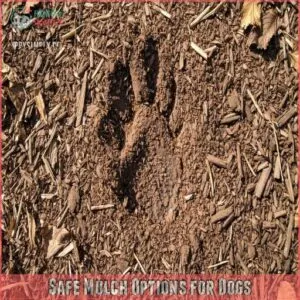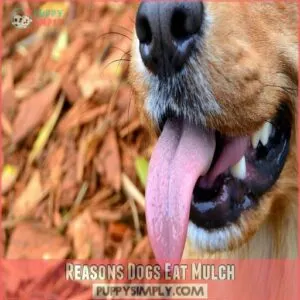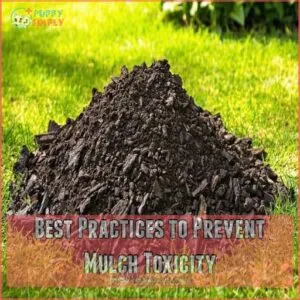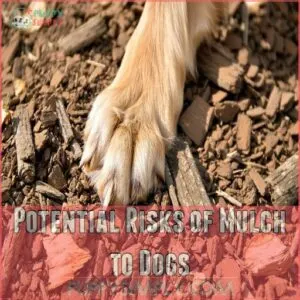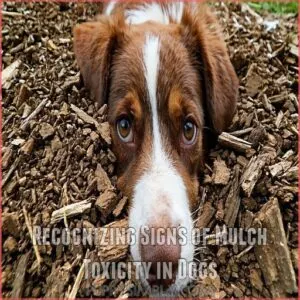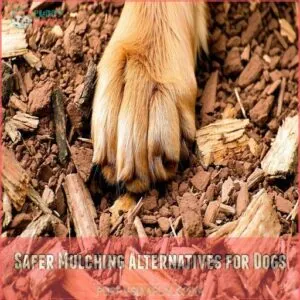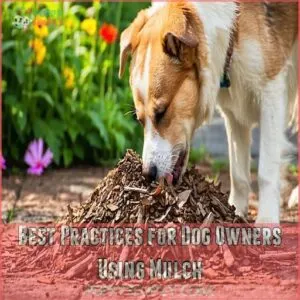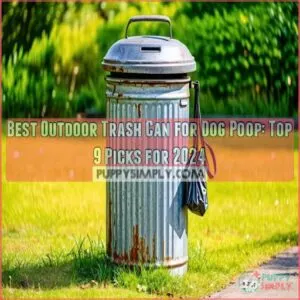This site is supported by our readers. We may earn a commission, at no cost to you, if you purchase through links.
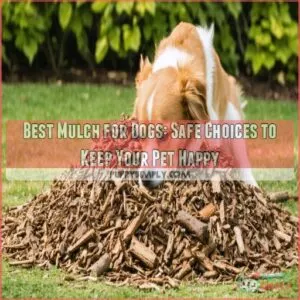 Finding the best mulch for dogs? You’re not alone!
Finding the best mulch for dogs? You’re not alone!
Many pet parents worry about mulch safety.
Luckily, some options are safer than others.
Cedar, cypress, and pine mulches are generally considered dog-friendly, offering pleasant scents and pest-deterrent qualities.
Untreated wood chips are another good bet.
However, avoid cocoa mulch—it’s toxic!
Rubber mulch is durable but might not be as aesthetically pleasing.
Remember, even safe mulches can cause tummy troubles if your pup decides it’s a tasty snack.
We’ll explore ways to prevent this and other hazards in more detail…
It’s all about smart choices for a happy, healthy dog and a beautiful garden!
Table Of Contents
Key Takeaways
- Choose dog-safe options like cedar, cypress, and pine mulch to keep your furry friend safe and your garden beautiful.
- Avoid toxic mulches such as cocoa and eucalyptus, which can pose serious health risks to your dog.
- Always supervise your dog around mulch to prevent ingestion and potential digestive issues.
- Regular garden check-ups and training your dog will help prevent unwanted mulch munching and keep your pet safe.
Safe Mulch Options for Dogs
When choosing mulch for your garden, it’s important to select options that are safe for your furry friends.
Pine and cypress mulches are excellent choices, offering natural protection without harmful chemicals that could hurt your curious canine.
Pine Mulch
Think of pine mulch as the helpful neighbor in your yard.
It’s cost-effective, dog-friendly, and comes with a fresh, natural scent your pooch will love.
This mulch doesn’t just look good; it can help keep pests at bay, bringing you peace of mind.
With its sturdy texture, pine mulch holds its ground in different weather, but make sure your pup doesn’t overindulge in sampling it.
If they do, don’t worry too much—it’s generally pet-safe.
Just keep an eye out for any sneezes or itchy paws, ensuring your garden remains a cozy hangout for everyone!
Cypress Mulch
For pet-friendly landscaping, cypress mulch is a solid option.
With its insect-repelling qualities, it keeps bugs at bay, ensuring your dog’s space stays enjoyable and safe.
Unlike cocoa mulch, cypress mulch doesn’t pose chocolate-related dangers and isn’t as enticing to cats as a restroom spot.
Cypress mulch is also a good alternative to bark mulch, which can pose risks if the pieces are large, the mulch is damp, or if it’s treated with chemicals learn more about mulch toxicity.
Affordable and long-lasting, it’s great for flower beds and vegetable gardens alike.
Just keep an eye on the depth—too much mulch can be a tripping hazard—and watch for any unexpected reactions in your pup.
After all, a happy dog is a healthy dog!
Reasons Dogs Eat Mulch
Your dog might eat mulch simply because they’re curious and like to explore the world with their mouths.
Sometimes chewing is just their way of investigating, but it can also be a sign they’re looking for entertainment or comfort.
Curiosity
Got a playful pup that’s drawn to mulch? Your dog’s curiosity is sparked by nature’s allure—sniffing and nibbling around the garden.
To keep them safe and their tails wagging:
Offer chewy toys that mimic mulch texture.
Opt for pet-friendly mulch like untreated wood chips.
You can also find a variety of pet friendly mulch options online, such as those found on pet friendly mulch websites.
Create a special digging spot with safe materials.
These simple steps make sure your curious chewer can explore scents safely.
Exploration
Beyond sniffing, your dog’s amazing sense of smell drives exploration.
They dig into mulch to investigate intriguing scents and textures.
This natural instinct, while adorable, poses risks.
Opt for dog-friendly mulch like cedar or pine bark to minimize hazards.
Always supervise playtime near mulch piles.
A safe garden is a happy dog!
Chewing
Ever noticed how your dog’s chomping habit targets everything in sight, including mulch? It’s like they think cypress and bark mulch are their new, favorite chew toys.
Dogs often chew on woods and other materials due to strong chewing instincts and boredom, so it’s important to redirect this behavior with appropriate chew options like safe chew alternatives.
But don’t let mulch munching become a problem. Switch to safer options like cedar mulch or rubber mulch, which are less enticing to gnaw. They’ll protect your pup’s health without sacrificing your garden’s charm. Keep things pet-safe and worry-free!
Best Practices to Prevent Mulch Toxicity
To keep your furry friend safe, steer clear of toxic mulches like cocoa bean and eucalyptus, which can cause harmful effects.
Even the safest mulch mightn’t agree with every pup, so it’s also wise to monitor for any allergic reactions.
Avoid Toxic Mulches
In the quest to keep your yard pet-safe, start by avoiding toxic mulches.
Cocoa bean mulch is a big no-no because of theobromine, the same stuff that makes chocolate dangerous for dogs.
Try these safer options instead:
- Pine Mulch: A natural, pet-safe choice that won’t break the bank.
- Cedar Mulch: Known for its lovely scent and bug-repelling qualities.
- Cypress Mulch: Mild and gentle, ideal for curious pups.
Always check the ingredients—chemically treated mulches or those made from toxic plants can spell trouble for your furry friend.
Monitor Allergic Reactions
Watching out for mulch allergies is key when your furry pal joins you in the garden.
Even with dog-friendly mulch options like cedar or pine, some pooches might still react.
Keep an eye out for allergy symptoms like:
- Excessive scratching or licking
- Red skin or rashes
- Sneezing fits
- Watery eyes or runny nose
If your dog’s behavior changes or they’re more lethargic, it’s time to contact your vet.
Switching to a different mulch might do the trick.
Remember, each dog’s different, and some may even experience seasonal allergies.
Safety first—ensure your garden’s as welcoming as it’s beautiful!
Potential Risks of Mulch to Dogs
When choosing mulch for your garden, it’s important to be aware of the potential risks it might pose to your dog.
Some types, like cocoa mulch, can be toxic and lead to serious health issues if ingested.
Cocoa Mulch
Imagine your pup wandering your garden, oblivious to hidden threats. Cocoa mulch may look and smell delightful, but it’s a serious risk. Packed with theobromine, like chocolate, it can turn your pet’s stroll into a trip to the vet.
- Toxic effects
- Tempting aroma
- Expensive vet bills
- Not worth the risk
- Go for safer options
Bark Mulch
Bark mulch? It’s not all sunshine and roses.
Big chunks? Choking hazard!
Damp stuff? Bacteria breeding ground!
Treated wood? Toxic chemicals!
Dyed bark? More potential problems!
Check your mulch carefully; your dog’s health depends on it!
Grass Clippings
Grass clippings might look like harmless leftovers, but they can be risky for your pet.
Dogs can have grass allergies, causing itchy skin or tummy troubles.
If your lawn’s treated with chemicals, that’s another worry.
Try these alternatives to keep your pup safe:
- Mulch Safety: Opt for pet-friendly mulch.
- Lawn Care: Maintain chemical-free grass.
- Dog Health: Supervise outdoor time.
Compost
Compost offers great garden benefits but can be risky for pups.
It might hide harmful bacteria or mold, making your furry friend sick.
Always keep a secure bin to prevent compost toxicity, especially from food scraps.
Look into compost alternatives or DIY options.
Enjoy the perks of compost tea and pet-safe gardening without compromising your dog’s safety.
Other Hazards
We’ve covered compost’s risks, but here are more mulch hazards to watch out for with your pup:
- Insecticides and fertilizers: These could be lurking in mulch, posing toxicity risks.
- Chemical-treated mulch: Leads to health issues.
- Sharp objects: Mulch might hide dangers like rocks.
- Chunky pieces: These can cause choking or blockages.
- Mulch allergies: Watch for itching or breathing troubles.
Recognizing Signs of Mulch Toxicity in Dogs
When your dog acts like they’ve had one too many rounds of play, it might just be mulch toxicity knocking.
Keep an eye out for vomiting, diarrhea, and odd behavior to catch any issues before they get serious.
Gastrointestinal Upset
Spotting gastrointestinal upset in your dog from mulch ingestion is important.
Watch for vomiting and diarrhea, common signs your pup might’ve munched on something toxic.
A sudden loss of appetite or signs of stomach pain, like whining or hunching, should raise alarms.
Consider mulch particle size too—smaller bits can cause serious intestinal blockages and distress.
Changes in Behavior
When your furry friend starts behaving out of the ordinary—like suddenly acting more playful or oddly anxious—it might signal mulch toxicity.
Dogs can show symptoms such as:
- Unusual dog aggression
- Increased fearfulness
- Changes in playfulness
- Heightened anxiety
- Loss of appetite
If you notice any of these behaviors after mulch ingestion, especially with cedar mulch, act quickly and seek professional help.
Physical Discomfort
Beyond behavior changes, physical discomfort can signal mulch toxicity.
Vomiting or diarrhea? That’s a red flag.
Increased thirst or peeing more than usual? Keep an eye on that, especially if cocoa mulch is involved, and consider seeking out products specifically designed to handle mulch dog diarrhea.
Sudden lethargy in your usually bouncy pup? Time for a vet visit.
These are signs your dog’s not feeling well.
More Serious Symptoms
Imagine your beloved pup suddenly having seizures or showing signs of kidney problems.
These aren’t just passing moments—they’re red flags waving urgently.
It’s like your dog ate chocolate but worse.
Get to the vet, pronto!
Here’s what you should watch for:
- Seizures and tremors
- Respiratory distress
- Lethargy
- Vomiting and diarrhea
Don’t wait; act fast.
What to Do if You Suspect Toxicity
If you think your dog’s chewed toxic mulch, act fast.
First, call your vet with details on the product and symptoms.
Follow their advice— they might suggest inducing vomiting or using activated charcoal.
Keep problems at bay by choosing pet-safe mulch like pine or cypress.
For emergencies, remember the ASPCA hotline.
Your dog’s safety’s in your hands!
Safer Mulching Alternatives for Dogs
When you’re choosing mulch for your garden, making sure it’s safe for your dog is essential.
Cedar, rubber, untreated wood chips, and straw mulches offer safer alternatives that protect your furry friend from harmful chemicals while keeping your garden tidy.
Cedar Mulch
When you’re choosing mulch, cedar mulch stands out as both durable and dog-friendly. It offers a charming natural aroma, keeps moisture well for those happy plants, and doesn’t harm your curious pup. Plus, it looks great, adding a natural, rich color to your garden.
- Retains moisture effectively.
- Naturally wards off bugs.
- Known for its longevity and appealing scent.
Rubber Mulch
Rubber mulch is a sturdy, versatile choice that fits right in your backyard.
It stands up to trampling, so feel free to let the kids and pets romp around.
With its chunky charm and long lifespan, it’s not just for gardens—think playground settings!
A cost-effective, dog safe mulch option, rubber mulch keeps your outdoor haven pretty and pet-friendly.
Untreated Wood Chips
Ever thought about using untreated wood chips in your garden?
These wood chip types are excellent for creating a dog-friendly yard, especially when paired with a pet-proof lawn that can withstand heavy foot traffic and urine tolerance, such as those discussed in guides for the best grass for dogs.
They minimize mulch toxicity risks, but they also make for easy maintenance.
Go for pet-safe mulch by sourcing untreated varieties, ensuring it’s free from chemicals. You’ll keep your garden lively and your furry friend safe!
Straw Mulch
Thinking about straw mulch? It’s a budget-friendly, pet-safe option. However, it burns easily, so keep it moist.
For a variety of straw mulch products designed specifically for dogs, check out straw mulch for dogs. Plus, you’ll need to replace it often because it breaks down quickly.
Want a longer-lasting solution? Consider cedar mulch – it smells great and lasts longer!
Best Practices for Dog Owners Using Mulch
When using mulch in your garden, it’s essential to keep a few best practices in mind to make sure your dog’s safety and happiness.
Whether it’s setting up barriers or just keeping an eye on your curious pup, you’ll want to balance garden beauty with dog-friendly practices to avoid any unexpected "gnawing" adventures.
Use Physical Barriers
Creating physical barriers is one effective way to keep your dog safe from harmful mulch.
Use fencing, gates, or obstacles to establish safe zones in your garden.
Even though these barriers provide an extra layer of protection, don’t skip the supervision—dogs can turn into little Houdinis!
Make sure your pet stays in dog-friendly mulch areas to prevent mulch toxicity.
Regular Garden Check-ups
Regular garden check-ups are like a wellness visit for your yard.
Here’s how to keep it safe: Check mulch depth often to make sure it’s effective.
Use pet-friendly deterrents like pepper to stop chewing.
Scan for hidden dangers—sharp objects, toxic bits.
Keep mulch away from water, preventing soggy spots that bacteria love.
Your garden’s health keeps your pet happy!
Training Importance
Training your pup is like planting seeds of good behavior.
You’ll find that a well-trained dog stays safe around pet-friendly mulch.
Focus on socialization and master obedience commands like "leave it" to avoid mulch mishaps.
Use positive reinforcement for a smooth learning curve.
Keep training fun with enrichment activities—turn routine into playtime to make sure safety and happiness.
Consult Professionals
Consulting professionals can be your best bet when choosing the right mulch for your dog-friendly garden.
Veterinarians offer invaluable insights focused on your pet’s health needs.
Remember to:
- Ask about dog-safe mulch selection for specific advice.
- Seek recommendations on pet-friendly landscaping.
- Explore options with professional lawn care providers.
These steps help create a safe, pet-friendly environment.
Supervision
Supervising your dog outdoors is like keeping an eye on a mischievous toddler.
Keep a close eye on their munching habits, especially around pet safe mulch.
Recognize what’s "normal" for your pooch to catch any odd behavior.
Provide safe alternatives for chewing—think squeaky toys instead of nature’s buffet.
Your role in dog-proofing is the key to yard safety.
Frequently Asked Questions (FAQs)
Is Cedar mulch safe for dogs?
Think of cedar mulch like an old friend—natural and reliable.
It’s safe for dogs, repelling insects with its pleasant aroma.
Just make sure your pup doesn’t chow down on it, avoiding any potential digestive issues.
What is the best mulch for dogs?
Opt for pine bark, cypress, or cedar mulch for your furry friend’s play area.
These choices are dog-safe and naturally insect-repelling.
Steer clear of eucalyptus and cocoa bean mulches, which can pose health risks to dogs.
How do I choose the right mulch for my Dog?
Finding the right mulch for your dog starts with choosing safe options like pine bark, cedar, or untreated wood chips.
Avoid toxic varieties like cocoa bean or eucalyptus mulch to make sure your garden is safe for your furry friend.
Is Mulch safe for dogs?
Mulch can be safe for dogs if you choose types like pine bark, cedar, or cypress.
Steer clear of cocoa mulch and chemically treated varieties, as they can be toxic.
Always supervise dogs around mulch.
Is rubber mulch safe for dogs?
Rubber mulch is generally safe for dogs, offering a soft, durable surface that doesn’t splinter.
However, if ingested, it can cause digestive issues.
Always supervise your pup around any mulch to prevent munching mishaps.
Conclusion
Ultimately, choosing the best mulch for dogs is a balancing act.
Remember, your furry friend’s safety comes first!
Prioritize cedar, cypress, or pine mulch – they’re generally safe and smell great.
Avoid cocoa mulch like the plague; it’s toxic!
Even with safe options, keep a watchful eye; some dogs are mulch munchers!
Regular garden checks and training can help.
With careful selection and a little vigilance, you can enjoy a beautiful garden and a happy, healthy pup.
Finding the right best mulch for dogs is key to peace of mind.

